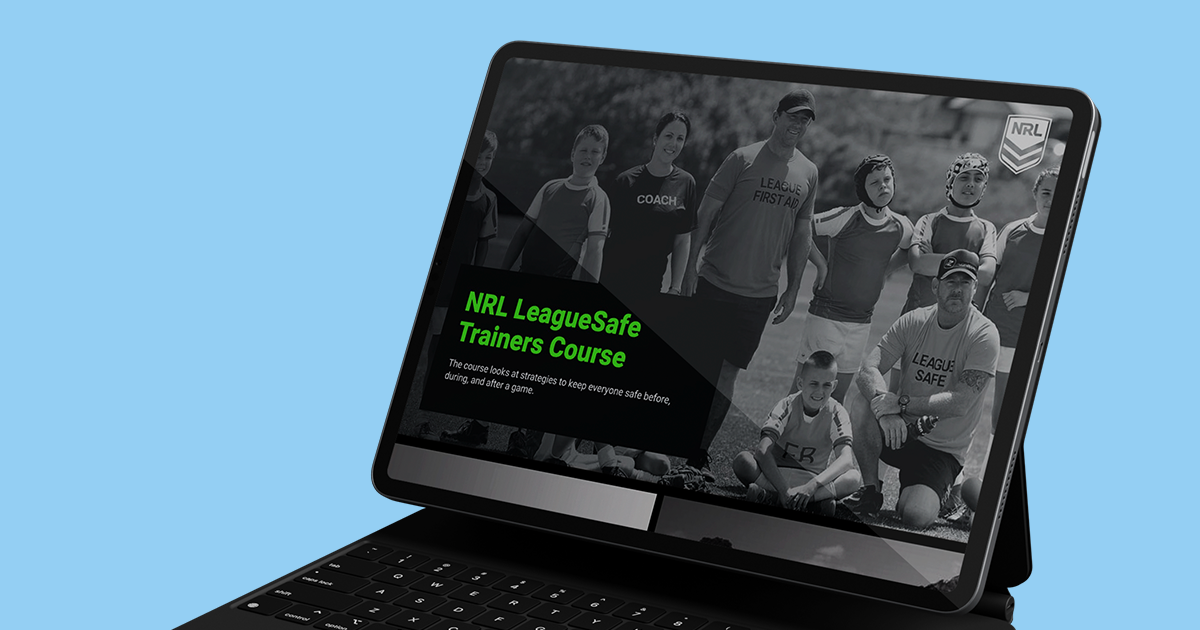
Commonwealth Games case study: imc Express e-learning content
Welcome to the third in our series exploring imc’s project with Birmingham 2022 Commonwealth Games. In this post, we will explore how the Commonwealth Games used the imc Express authoring tool to create their own eLearning content in-house.
The Birmingham 2022 Commonwealth Games organising committee needed a lot of custom content to support their workforce of over 50,000 employees, contractors and volunteers. Ideally, this would be created in-house, meaning they needed an efficient, easy-to-use authoring tool to produce lots of eLearning content in a short period of time.
Why did the Commonwealth Games choose imc Express?
imc Express is an easy-to-use authoring tool that takes the hassle out of content creation. Learning teams can easily import text from Microsoft Word, add multimedia content, drag-and-drop images and build interactive learning activities to build engaging learning experiences. To support the most inclusive Commonwealth Games ever, video content is automatically subtitled, ensuring it’s accessible to the entire workforce.
On top of this, imc Express offers a range of pre-made and customisable design templates, along with didactic templates to help authors convey their content in a didactically meaningful way. Content is adaptive and responsive for all devices, ensuring it’s suitable for the Commonwealth Games’ large, diverse audience who may be accessing training from desktop computers, tablets or smartphones.

Creating content with imc Express
The Birmingham 2022 Commonwealth Games team has two imc Express ‘super users’ with the overall responsibility for managing the eLearning content creation process. These super users will set up the templates and send them out to each functional area in line with demand for new learning content.
The templated approach will empower more people to create learning content without needing extensive development or design experience, while also being able to create engaging and interactive eLearning content instead of a plain PDF.
Content straight from the in-house experts
The Birmingham 2022 Commonwealth Games only has the budget for a select few highly interactive modules to sit on their LMS, and with no dedicated in-house content provider, imc Express will make it much easier to spread the content creation workload across functional areas of the organisation, ensuring modules come straight from the experts for the best-quality training.

Why Birmingham 2022 Commonwealth Games needs custom content
With 43 different functional areas (or departments), the Birmingham 2022 Commonwealth Games needs to accommodate a wide range of learning requirements.
There are 279 different volunteer roles within these functional areas, covering everything from transport to media to medal ceremonies; much of which will be unique to the Birmingham 2022 Commonwealth Games.

How the Commonwealth Games is using custom eLearning content
This custom eLearning content will supplement the in-person training which takes place within the Commonwealth Games venues in Birmingham, ensuring volunteers can make the most of their face-to-face time. The modules created in imc Express will help volunteers know what to expect before their in-person training, giving them a useful overview of their roles and the tasks they can expect to perform.
Over 50 courses were created, in-house, in no time. Many static documents and plain text resources were transformed into engaging, interactive eLearning. This was made significantly easier by the fact that with imc Express, a single plain text input can be converted into multiple outputs, such as SCORM, web content or ebooks. This content was then imported directly from imc Express into the Learning Magagement System (LMS), reducing manual content upload.
Providing this content as soon as volunteers have their roles, ensures that they can start to prepare for the games immediately without having to wait for their face-to-face training. They will have access to photos, videos, maps and more created with imc Express by leaders in their functional area, ensuring they can turn up for their face-to-face sessions with a foundation of knowledge.
This primarily self-created approach will also allow the Birmingham 2022 Commonwealth Games team to accommodate inevitable last-minute requests for learning content, as they can all be quickly created in-house using templates and the imc Express tool’s artificial intelligence to pull together accessible, attractive and engaging learning resources for thousands of volunteers, contractors and paid employees.
More about this project
Join us for part 4 when we will take a look at the implementation of imc’s LMS for the Birmingham 2022 Commonwealth Games, including the challenges they overcame and how they launched the LMS to a workforce of over 50,000…

A future-proof LMS for 2022 Commonwealth Games
A future-proof digital learning solution with multitenancy LMS to train large numbers of volunteers and contractors at the 2022 Commonwealth Games within a short time frame.

A holistic learning management experience for Australia’s national rugby league
A rejuvenated approach to modernise NRL learning centre portal with a fully-integrated LMS that increased participation rates and positive learner feedback.

Birmingham 2022 Commonwealth Games case study: The solution
Welcome to the second in our series of posts exploring imc’s project with Birmingham 2022 Commonwealth Games. In this post, we will look at imc’s solution, including how the design tied into the Commonwealth Games organising committee’s unique requirements.
Following Birmingham 2022 Commonwealth Games’ public procurement process, imc’s proposed solution clearly came out on top. This was, in part, thanks to imc’s experience with other sporting organisations, such as Australia’s National Rugby League, along with their on-budget and on-brief solution.
Birmingham 2022 Commonwealth Games project kickoff
The project kickoff took place in November 2021, with the initial go-live planned for late February 2022 - a very tight timeframe for such a large-scale, complex LMS project, so efficient working practices were a must.
An inclusive learning platform
A key consideration for this project was that the Birmingham 2022 games will be the most inclusive Commonwealth Games to date, with more medals for women and a bigger para-sport programme than ever before. Birmingham is also a very diverse city in the UK’s West Midlands. This need for inclusion had to be reflected in the choice of learning platform. The LMS needed to be simple, accessible and suitable for use by a wide range of learners.
Building an LMS within time limitations
Additionally, it was vital that this programme remained within the planned scope. With such limited time, it was not an option to stray outside the initial plans, so the Commonwealth Games organising committee and imc agreed very early on that this LMS needed a very clear focus with no room for scope creep.

Designing the programme
With so many volunteers and contractors involved in the Birmingham 2022 Commonwealth Games, it was essential that the programme ran efficiently and didn’t take up more time than was absolutely necessary. The last thing the Commonwealth Games organising committee wanted was to ask a volunteer working four shifts to participate in a full week of training, so a smart design was extremely important.
All employees, contractors and volunteers involved with the Birmingham 2022 Commonwealth Games must attend four-hour face-to-face orientation sessions to help them familiarise themselves with the venues and procedures specific to each location. Therefore, a blended learning programme was quickly established as the best approach, with the LMS providing additional bitesize training and support while protecting limited face-to-face time.
Integration with a workforce management system
The Learning Management System (LMS), B-Bright, takes user data from workforce management system Rosterfy, the volunteer portal. For the Birmingham 2022 Commonwealth Games, this takes place through a simple data transfer service, but with more time to prepare for future games, these systems will be integrated. This is one of the advantages of a multi-games contract – lessons learned from this version can be directly implemented in future versions, instead of starting from scratch each time.

Managing users
There are thousands of people involved in the Commonwealth Games, all of whom have different learning needs and roles to prepare for, across 43 functional areas and 279 different volunteer roles. The data transferred from Rosterfy to the LMS flags the type of user and automatically gives them access to the relevant training within the course catalogue.
This data also tells the LMS which functional area the learner works in, so they are also automatically enrolled into role-appropriate courses. This removes a huge amount of manual work for the organising committee, and ensures that the user management process is streamlined and efficient,
A future-proof solution
The LMS is built with multitenancy in mind. While this solution will be operational for the six months around the Birmingham 2022 Commonwealth Games, the platform itself will be reused for future games.
User data for future games will be completely separate from the Birmingham 2022 users, meaning that unique designs and content can be applied to the LMS without affecting other host cities’ experiences.

An agile approach
This solution has been designed with future games in mind right from the start of the process. While the Birmingham 2022 Commonwealth Games requires a quick, on-brief solution, there will be much more time to automate more elements of the platform for future games. Owing to this agile approach, the larger scope of more complex learner journeys and close integration with other systems can be iteratively rolled out over time. Getting started with what is required now with built-in flexibility means that the solution will be ready to adapt to what is needed in the future.
More about this project
Join us for part 3 when we will take a look at how the Birmingham 2022 Commonwealth Games organising committee used the imc Express authoring tool to create their own customised eLearning…

Part 1: An LMS for the 2022 Commonwealth Games
The challenges to designing a digital learning solution for a large & diverse audience at the 2022 Commonwealth Games in Birmingham.

A podium spot with eLearning
Training is not only essential for the professional athletes, but their trainers, referees and crew members also need continuous professional development. We tell you how that works with eLearning.

How to Implement Compliance Training Online
Here we look at how to implement compliance training online using a learning suite to automate repetitive tasks, track learner progress and ensure that refresher courses and recertifications are completed successfully.
By leveraging the latest learning technology, your organisation can stay compliant while saving valuable time and money, as well as engaging employees with the training process.
A modern ‘learning suite’ will comprise capabilities as both a learning management system (LMS) and a learning experience platform (LXP). When it comes to mandatory training to stay compliant with legal or industry regulations, the former is most relevant.
So below we look at 5 key capabilities you need in a good LMS for compliance training. We then offer 5 quick tips for making compliance training engaging, as well as effective.

Automate Compliance Training
The imc Learning Suite enables you to define target groups for training courses and book them automatically. Progress is continuously documented from the time of booking, and learners can be reminded by automatic messages to complete these courses within the required period.
An automated refresher training mechanism ensures that the course is repeated regularly, so that the employee always meets all compliance requirements. All status changes are stored throughout the entire process, ensuring that all compliance-relevant activities can be tracked and monitored across the board.
By using personal profile data, new employees can also be automatically trained according to requirements during the onboarding process. The imc Learning Suite also supports maintenance through necessary repeat training and recertification.
All compliance-relevant activities are supported by the system, from the nomination of target groups to the tracking of course progress and the so-called “chasing“, right through to the reporting of training measures.
Keep the above info block but remove ‘the’ to read just ‘Reduce susceptibility to errors’.

Assign Training
The training assignment process describes the formation of target groups for defined compliance requirements and the selection of training measures that must be carried out to meet the requirements.
The imc Learning Suite provides support by defining and selecting target groups via inclusion and exclusion rules. Assignment criteria can for example be courses, user attributes, course types, learning paths, skills, group assignments or job profiles. Target groups can be generated automatically via batch jobs that can be configured as desired or after a manual start.

Learner Tracking
The learner tracking process describes the continuous monitoring of the learning progress of training measures. So you can be sure that you meet the compliance requirements. The imc Learning Suite makes the current status of training measures traceable at any time and facilitates progress control via reports, automatic notifications, and the course progress display.
The current status of the training activities can be graphically displayed in the imc Learning Suite on a reporting dashboard. The reports can be configured individually and offer filter options so that those responsible are always informed about the status and possible need for action. On request, the reports can also be sent to the compliance officers on a regular basis or triggered by predefined events.

Chasing
For training measures that must be carried out due to legal or internal company compliance requirements, there is often a fixed timeframe for successful completion. If such deadlines are not met, this can lead to the employees not being able to perform tasks due to a lack of professional qualifications or not being entitled to perform them due to legal requirements.
To support the successful completion of such training measures, employees are not only informed about the status of their mandatory measures, but are explicitly requested to complete them within the defined period. In the compliance environment, the term “chasing“ has become established for this task. Compliance officers can not only easily create compliance training courses in the Learning Suite user interface, they can also assign validated content to users of predefined target groups.
With just a few clicks, graphically appealing and meaningful reports on compliance status can be activated. In addition to the monitoring and chasing options available via the user interface, the notification module of the imc Learning Suite can be used to define the time intervals at which the distribution groups are to be informed by email about the compliance status of employees.
Refresher Training & Recertification
The recertification workflow controls the fulfilment of compliance requirements for the respective target groups on the basis of a dynamically calculated due date. It also triggers recertification processes either manually or automatically at the optimum time.
The efficient design of the recertification process creates a high level of up-to-date information, relieves those responsible for compliance, and reduces sources of error.
!! See an error in this sentence on the original PDF!!

5 Tips for Engaging Compliance Training
Know your target group
Even though compliance today affects almost all work areas and employees, a training course should always be tailored to the target group for which it is intended. Does the target group need in-depth knowledge about compliance, or is it enough to sensitise them?
Focus on performance and outcome instead of mere information transfer
In every area of compliance there are a multitude of problems and rules. But not every possible scenario is equally relevant. Awareness of specific risk areas and possible measures are more important to the learners than knowledge of all conceivable compliance scenarios. The focus should therefore be on the cases that the target group can actually encounter or that have occurred in the past.
Focus on behaviour change
Simply learning rules by heart causes rejection by many people and rarely fulfils the goal of compliance training. After all, the learners should behave according to the compliance rules and not be able to give a lecture on these rules. The focus of a compliance training course should therefore be on changing behaviour.
Use authentic content with consequences
Examples and concrete cases where the learners can test their knowledge in an application-oriented way are preferable to knowledge queries. It is important that these examples can also be encountered by the target group in everyday work. The more concrete a case study is and the sooner it fits into the target group’s working life, the more interesting it is for the learners. This is the only way to show credible consequences that convey the relevance of the content to the learners.
The format is crucial
Compliance as an often dry perceived topic must be brought to life. Even more than with other topics, an initially boring-looking compulsory training can become a learning experience by using scenario-based approaches and storytelling, gamification elements or interactive elements to bring more life into the training. In search of suitable content? Use our popular standard content or develop content perfectly tailored to your situation together with our content experts.

The Role of Compliance in Digital Learning Transformation
Get to know more about the five benefits of how compliance training can make digital learning transformation a fundamental part of a progressive, digitally-savvy organisation.

Don’t call it compliance!
Compliance training - the term alone is a red flag for many employees. We give some tips how to create an interesting training instead.
Contact person

Birmingham 2022 Commonwealth Games case study: The challenge
Welcome to the first in our new series of posts exploring imc’s project with Birmingham 2022 Commonwealth Games. In this post, we will reveal the challenge faced by Birmingham 2022 Games, and what they needed from their new learning management system.
About the Commonwealth Games?
The Commonwealth Games bring nations together in a colourful celebration of sport, human performance and culture. Birmingham 2022 will see around 4,500 athletes from 72 nations and territories compete in 19 sports and eight para-sports. Much like the Olympics, the Commonwealth Games takes place every four years, moving cities for each event. As the biggest event ever to be held in the West Midlands, Birmingham 2022 is expected to attract more than one million spectators to the city and have a global TV audience of 1.5 billion.

The training requirement
With each event comes a mammoth training requirement. With a workforce of over 50,000 volunteers, paid employees and contractors to rapidly upskill, Birmingham 2022 needed a learning management system (LMS) to streamline the training process for their diverse team.
To find a new LMS, Birmingham 2022 went through a public procurement process to find the right vendor. Birmingham 2022 has pledged to be the most sustainable yet, so sought a solution that could be reused across a multi-games contract, by Birmingham 2022 and future committees.
For Birmingham 2022, it was vital to ensure efficiency and value for money, so it was crucial that they chose the right LMS from the very beginning. The Commonwealth Games Federation’s vision was for better knowledge transfer between organising committees, with systems and contracts carrying over from one Game to the next to reuse as much as possible.

Plans for a blended learning programme
Birmingham 2022 knew that they wanted a truly blended learning programme, comprising eLearning, digital resources and live face-to-face training sessions. The addition of the online element was relatively new, and driven in part by the challenges posed by COVID-19. This would be in contrast with the very simple LMS used by the Gold Coast 2018 Commonwealth Games, which was essentially used for ‘click next’ learning with no tracking or reporting.
The shift in focus to blended learning would enable Birmingham 2022’s training team to ensure that valuable time wasn’t taken out of face-to-face sessions to deliver soft skills training. This meant that workforce would receive their venue-specific training in person, while accessing role-specific and customer service-focused training online for more efficient learning.

Designing for a large, diverse audience
An important part of this project would be the huge learner audience, of 35,000 contractors, 14,000 volunteers and 2,000 paid employees. Additionally, this would be a very diverse audience, comprising different ages and levels of technical ability, meaning the LMS needed to be extremely accessible and user friendly.
With so many volunteers and contractors, Birmingham 2022 needed to ensure that their event scheduling platform, Rosterfy, would communicate with their LMS. This ability to transfer data from Rosterfy to the LMS would save Birmingham 2022 a lot of time that would otherwise be spent on manual data entry.
Finally, the LMS would need to support multiple different user groups over the course of the contract, along with different branding and content, so the chosen LMS needed multitenancy functionality.
Following an extensive tender process, the Birmingham 2022 Commonwealth Games selected imc as their enterprise LMS vendor of choice. The project commenced in November 2021 – nine months before the start of the games. With this in mind, it was time to get to work on creating the perfect solution in a limited timeframe.
Join us for part 2 when we will take a look at the solution imc created for the Birmingham 2022 Commonwealth Games…

A holistic learning management experience for Australia’s national rugby league
A rejuvenated approach to modernise NRL learning centre portal with a fully-integrated LMS that increased participation rates and positive learner feedback.

A podium spot with eLearning
Training is not only essential for the professional athletes, but their trainers, referees and crew members also need continuous professional development. We tell you how that works with eLearning.

What is Digital Learning Transformation and how does L&D maximise its impact?
Digital Learning Transformation is about much more than taking your offline training materials and making them viewable online. It’s a complete, collective mindset change in how training gets done across an entire organisation.
In this blog, we offer a brief introduction to the concept of digital learning transformation, including the reasons and expected benefits and - if you’re in L&D - how to do it well.

The Broader Digital Transformation Context
Digital transformation is a managed approach to integrating digital technologies across all areas of an organisation. It marks a fundamental change in how business gets done.
Every business will have its own priorities and pain points that may be the primary driver(s) of digital transformation, but the goals and incentives tend to include:
- Cost savings and increased efficiency through reduced need for travel, time on face to face or paper-based communication, etc
- Greater cross-departmental knowledge sharing, breaking down silos and leading to new cocktails of ideas
- Enhanced data gathering, giving leaders more insight into trends, customer needs, opportunities and threats - enabling better-informed strategies to be formed
- Future-proofing the organisation, making it more adaptable to change and the integration of new solutions that build upon the existing technologies.
While digital transformation as a concept has taken hold over the last 5 years and seen accelerated demand since 2020 in the midst of the Covid-19 pandemic, its business benefits have long been demonstrated. In fact, research by MIT back in 2013 showed that digitally mature companies were 26% more profitable than their peers.
Those that lag in this area risk getting left even further behind more digitally-focused companies in 2022 and beyond.

eLearning for Employee Engagement, Performance & Retention
Few large organisations in 2022 have wanted to or been able to continue with face to face onboarding and training during the pandemic. While most will have had a level of elearning already in place for the basics of company processes and compliance training, many then took the same principles to further L&D content, making it available online via a learning management system (LMS).
However, it's crucial to view this solution as an extension of existing box-ticking exercises required for health and safety or other compliance training that short-changes employees and the business as a whole.
LinkedIn’s 2018 Workplace Learning Report found that 69% of non-millennials see development as important in a job, while this figure rises to 87% for millennials. This means that the competitive advantage to be gained from enhancing learning and development opportunities will increase in its importance for engaging employees over the coming years.
The benefits of eLearning for staff retention are even clearer:

Source: LinkedIn Workplace Learning Report
According to research by Oxford Economics and Unum, the cost of replacing an employee earning £25,000 is over £30,000 on average when you factor in all costs, and this may not even account for the associated inefficiencies caused by disruption and loss of knowledge and experience.
Digital learning transformation looks at how to not only make elearning possible but how to make training as effective, engaging and enjoyable as possible.
As 94% of employees would stay longer if they felt their company was investing in their career, making learning materials not only accessible but engaging and personalised through an integrated Learning Suite could bring vast improvements in morale and reduce attrition.
Such a system combines the top-down training facilitated by an LMS with the bottom-up, employee-led learning characterised by a Learning Experience Platform (LXP). Investment in such digital learning solutions could be repaid many times over across a large organisation from just the reduced recruitment costs alone.
Transformation Buy-In at Leadership Level
For digital learning transformation to have a real impact across the organisation, L&D managers need to first ensure buy-in from their fellow leaders, starting from the top:

CEO
The big boss loves speed - in decision making, in implementation, and in bottom-line results. Demonstrate how digital learning will enable new products and services to be rolled out faster, as training can be created and delivered quickly, even across borders, and updated with minimal time and fuss down the line.

Head of Finance
A key consideration for finance is minimising and cutting costs where possible of course. Sell the idea of digital learning to this team on the basis that it reduces costs in the way of face to face trainers, room hire, travel and materials. Rather than an investment (a cost), it is a cost-saving device for which you may be able to demonstrate a clear business case and ROI.

Head of IT
The techies love control. Rather than selling the Head of IT on the concept of digital learning, you may find that he or she is enthusiastic but wants to be actively involved to ensure integration with existing systems. See this as a collaboration where you may need to hand over a level of control.

Legal
A well set up learning platform is a powerful asset for legal/regulatory compliance. It provides clear information on required training and can provide alerts when refresher training is required. An easy sell to an in-house or external legal team.

HR
Recruitment, onboarding, training, morale and retention are all key considerations for the Head of HR. L&D and HR are closely aligned anyway - if not part of the same People department. Digital Learning Transformation does require a great deal of data sharing and integration with HR systems, but done well, HR and L&D will have a seamless, beautiful relationship for ever after.
Key Steps to Digital Learning Transformation
A digital learning transformation programme requires careful planning, implementation, assessment and improvement. Any such technology implementation can be broken down into distinct steps for success:
- Plan
- Consult
- Implement
- Test
- Measure & Analyse
- Improve
To break each step down into greater detail:

Plan
You will have done a level of planning in order to win the support of department heads. In order to maintain that support, you’ll need to carefully scope and cost the technologies you’re looking to introduce and the human resources needed for their implementation.
What existing processes will be retired and what are the direct replacements for each one in the new digital learning environment?
As so many technology projects stray beyond expected timescales, give yourself plenty of buffer time so that you don’t miss deadlines and start losing support from your peers.
Consult
Communication is vital for a successful digital learning transformation programme. Many IT projects fail not through a poor choice of technology, but through lack of communication beforehand in order to generate understanding and buy-in from end-users.
At the consultation stage, learn about what the key pain-points are within each department and try to tailor your digital learning solutions to help ease them.
Help each department to understand the benefits of digital learning transformation for their roles and you’ll find less friction and greater user adoption of new systems and processes post-implementation.
Implement
Don’t try to implement every project within the digital transformation programme in one spectacular hit. There will be disruption - good and bad - so limit the bad and overall shock to the organisation by rolling out to a limited cohort - perhaps the department where you have greatest buy-in first.
Introduce new tech and eLearning content gradually, replacing previous training methods bit by bit. Look for what systems and content people are finding confusing and what really enthuses them.
Test & Measure
As your early-stage digital learning projects bed in, analyse the data that comes back from your learning platform. What are the key metrics you are looking to improve and how does the new solution fare compared to previous methods?
Analyse, Discuss & Improve
Again, communication is essential to making your digital learning programme maintain its early momentum. You’re gathering quantitative data, but don’t ignore qualitative feedback from each group of learners and their managers.
What has been annoying? What hasn’t worked? What could be improved?
Within each individual roll-out project, mistakes will be made - that’s normal. Those mistakes will be forgiven if you listen to the feedback, take notes, and act as quickly as possible to address them with tweaks to your roll-out.
Transform the Culture
There is only some much you can do in leading a digital learning transformation programme before it could feel less collaborative and more like another top-down demand. Who has engaged most with both the process and the benefits from the early stage implementations?
Laser in on these people and try to empower them as advocates of the new solutions - even coaches for their peers who could use support.
With an army of internal activists, user adoption can start to spread like wildfire, making your digital learning take hold and really transform the culture of your organisation.
Hopefully, the above points have given you some useful food for thought in advance of your own digital learning transformation programme.
If you’d like to speak to one of our digital learning experts to discuss how our experienced team and solutions could help you, do feel free to contact us here at imc for an informal discussion of your organisation’s requirements.

Compliance in Digital Learning Transformation
Get to know more about the five benefits of how compliance training can make digital learning transformation a fundamental part of a progressive, digitally-savvy organisation.

Connecting Learning and Business Performance
A forum article about how leading businesses in Australia connect their learning journeys to their wider organisational objectives.
Contact person

The Role of Compliance in Digital Learning Transformation
Here we look at the important role of Compliance within digital learning transformation projects. Whether you have an Audit / Compliance or L&D role, digital transformation is likely impacting your plans, especially if you work for a large, forward-thinking organisation.
According to Gartner, global IT spend will hit $4.4 Trillion in 2022. Despite geopolitical uncertainty and residual pressures from the pandemic, business and IT leaders are actually looking to invest more in digital technology, in order to ensure greater flexibility and future-proofing of their organisations.
In fact, “Investment in direct digital transformation projects is projected to grow at a compounded annual rate of 16.5 per cent from 2022 to 2024” according to the International Data Corporation.
When it comes to digital transformation programmes, leadership teams are often sold on the ideas of faster processes, cost-savings and slicker sales enablement. For L&D, the Covid-19 pandemic accelerated the trend towards digital learning, as the face to face classroom environment became impractical.
What tends to get neglected within digital transformation is the area of Compliance. Legal and regulatory compliance is often seen as a tick-box exercise - “make sure passwords are secure for that new software”, “make sure the new guy gets his health and safety walkthrough before he starts” etc.
However, digital transformation can deliver as much in the way of improvements and efficiencies for Compliance teams as for any other department, while embedding compliance considerations can streamline every department’s processes by automating many recurring tasks related to training.
If you are involved in a digital learning transformation project, here we look at some of the key compliance considerations and potential benefits.

Automated alerts to new laws and regulations
A key role of Compliance teams is to keep track of the latest applicable laws and industry regulations, then liaising with L&D and / or relevant departments in order to roll out training accordingly.
When a robust, well-integrated learning platform is in place and you have an easy to use elearning authoring tool, the Compliance department may be able to update or add relevant information to the platform themselves so that push notifications will get sent to the appropriate employees automatically and if necessary, instantly.
Alternatively, Learning and Development teams can integrate the new information into the next round of training made accessible in the right place, at the right time.
Hassle-free audits
You may be quick and diligent when it comes to delivery of compliance training, but when it comes to an audit from external bodies, this needs to be proven.
Digital learning transformation reduces or completely removes the need for certification paperwork, so that demonstrating the appropriate level of training and accreditation becomes much quicker and easier. Gone are the days of lost certificates - hiding in the wrong file.
A good learning management system (LMS), such as the imc Learning Suite, makes all training and certification information easily navigable and searchable.
Personalised learning and refresher training
Often, compliance training is required when an employee joins a company or starts a new role. This means that revised or refresher training is required on a very individualised schedule.
Digital learning solutions enable these requirements to be managed for each employee as they progress through an organisation or take on new sideways responsibilities.

Powerful data
Compliance teams are often under pressure to do their jobs while staying out of the way as much as possible in order to allow employees to get on with their day to day responsibilities, such as customer service, operational work or revenue generation.
A digital learning platform gives L&D and compliance teams access to useful data so that trends can be seen in where an individual might need additional support for certain aspects of training or where a certain course is causing strange delays or roadblocks.
Such data can enable personalised learner interventions rather than bombarding a whole department with additional training that only a few people need to stay compliant. It also allows Compliance or L&D teams to improve training content that causes bottlenecks for a whole cohort of learners.
Risk mitigation
The whole point of the Compliance function is to allow an organisation to run fluently while staying on the right side of the law or industry regulator.
Through access to data generated by digital learning systems, a Compliance manager is empowered to better manage risk across the company. An effective digital transformation programme integrates every department and a great deal of their training.
Without acting like a ‘Big Brother’ presence in the company, the Compliance team can look into the development of processes and related training, offering guidance and risk mitigation processes along the way.
In Summary
The five principles above offer a guide to how Compliance teams and their collaboration with L&D can make digital learning transformation a fundamental part of a progressive, digitally-savvy organisation.
For those companies on a broad digital transformation programme, Learning and Compliance can help every department to run ever more smoothly and efficiently while managing the risks that come with any change much more effectively.

Don't call it compliance
Most of the time, employees are reluctant to complete mandatory compliance training since it's always unengaged and dull. We give some tips of creating an interesting training instead.

Efficiently implement compliance topics
Discover how to improve employees motivation and learning experience by using a modern learning management system platform.

Delivering Measured eLearning Results
Here we look at how to plan successful eLearning that will transform results across your organisation - and it all starts with defining your training needs in the context of wider business goals.
Get the planning stage nailed, with buy-in from all your stakeholders (including your learners), and the rest can fall into place and feel like a breeze.
The problem with many eLearning projects though - as with many technology projects - is that so many people leap straight into choosing the solutions before they’ve really identified and agreed on their current and future training requirements.
So here we’ll offer a step by step guide to successful eLearning for L&D managers so that your colleagues and learners will love you.

eLearning is Now an Expectation
eLearning is now a common way for organisations to deliver training and your employees are likely to have used it in some capacity - even if it’s just during their education or a company onboarding process.
It has now evolved into a standard way of making training content available any time and anywhere, enabled by ubiquitous internet access by mobile or WiFi, and by websites or learning platforms making it accessible on phones and tablets, as well as a desktop computer.
During and post-pandemic, eLearning will be the only way for training to happen at all for many organisations.
So as there are now fewer barriers to delivering eLearning and it has become so important, here are key steps for making it effective:
1. Needs Analysis and Consultation
Arguably, this is the most important part of an eLearning project, because if done well, it gets everyone on board to help you and gives you the reasoning and structure for every subsequent stage.
- Why this project? What are you looking to achieve? If you have eLearning in place already, what improvements are you looking for, and if you don’t - what do you want this project to bring?
- Is eLearning suitable? Usually, the answer is yes - as knowledge-based content allows learners to consume it at the time, place and pace that suits them. However, for some manual / skills-based roles, it may not be the case, so could traditional, face to face training or a mix - blended learning - be the best choice?
- Cost-benefit analysis - what might this project cost and what are the expected business benefits in terms of cost-saving, efficiency or revenue generation?
- What do your learners want and need? Listen to their views on knowledge and skills gaps, and where there is an agreement, look at a bottom-up approach to complement top-down from L&D and HR management. If learners feel that they have contributed to the process, they are much more likely to engage when the eLearning is ready.
2. Resourcing the Project
However small your L&D team, delivering an elearning project should always be a collaborative project and involve multiple professionals.
The same person may perform more than one, but rarely all of the roles below, so the L&D manager will need to resource at least the following:
Project Manager
Who will lay out the milestones and timescales and work to keep everything and everyone on track?
Subject Matter Expert (SME)
Depending on the nature of the training, the person or people who understand the subject and can lay out the curriculum and materials.
Instructional Designer
The person who can translate the content into the storyboards and course progression to help people learn in the most effective manner, with an understanding of what works in an electronic format.
eLearning Developer
The technician with the skills to turn the plan into the reality of an eLearning course, including text and images, audio, videos or any other media, along with the ability to track, measure and collate data on learner progress.
Unless you work within a very large L&D team, you’ll need to look outside your organisation and outsource some or all of the above roles. A specialist eLearning company will tend to have skilled professionals with experience in working well with clients or taking responsibility for the entire project efficiently.
So how do you choose the best eLearning company for your needs if you go down that route? Many will have slick sales professionals and showcase multiple awards, but what matters most is experience working with companies like yours.
If you are part of a large, global organisation, does the eLearning provider have experience at that scale and of multinational, even multilingual projects?
Do they have experience in your sector?
These details are much more important than a sales presentation!
3. Design & Development
Again, planning this stage in advance is key. Does your project need to run within a specific timescale or a particularly tight budget? Both these factors will affect the nature of the eLearning that is feasible.
What mode of delivery is most suitable for the nature of your training and your group of learners? Text and images might work well for purely informational content and knowledge retention, whereas training the ability to adapt to on-the-job situations like customer service may lend itself to scenario-based training and something more interactive.
Close collaboration between the subject matter expert and the instructional designer will allow for the content to be delivered in the best possible way while adhering to any technical constraints.
The instructional designer then needs to work closely with the eLearning developer to bring the content to life, ensuring that it works well on any device that may be used and that it is accessible for any type of current or future learner.
4. Quality Assurance
An important point here is that quality assurance (QA) is not a task to be done only by the developer as a final step. Good QA is done independently by someone external to the design and build process, as those people may have become too close to see all the potential real-life issues.
Ideally, the project managers, SMEs, and end-user managers and even selected learners will all have the opportunity to offer feedback on eLearning before it is signed off and rolled out.
5. Roll Out & Implementation
Most technology-related projects that fail do so not because of an issue with the product, but with the communication and implementation process.
New systems often turn up as yet another piece of work - something else to think about and squeeze in around the existing workload.
If there was adequate consultation at all levels during stage 1, the implementation of eLearning should arrive not as a surprise and even as a welcome addition, because the benefits to learners and managers will have been communicated and expected.
Rather than having to convince employees to engage with your new eLearning, the focus can be on guiding learners and managers in how to make it work well for them.
6. Measurement & Evaluation
How will you measure the benefits of your eLearning project?
What metrics will the L&D team measure to judge effectiveness?
What metrics do other stakeholders care about?
Along with your own learning outcomes, taking the targets of other departments into account will help to make this a more collaborative and successful eLearning project.
Don’t neglect subjective feedback alongside the quantitative results in terms of learning outcomes and business impact. How much your learners enjoy and engage with the training is an important factor when looking at how well it will work for future learning needs, and what you might want to change or tweak.
All eLearning projects are unique, but by following each of the six key steps above, you can help to minimise the common risks and maximise the benefits and overall success.

How much does an LMS cost?
How much does a Learning Management System cost? And which will appear after the implementation? We share some insights and explain, what these questions have in common with buying a house.

"The users decide whether or not a learning offer is successful'
"The goal of a learning platform must be to help people do the tasks in their job better," says Uwe Hofschröer from Learning Strategy Consulting at imc. In the Job Slot, he explains what he means by that.
Contact person

Increase Customers Live Time Value and Earn Their Loyalty
Here we look at how to improve customer service, retention, satisfaction and live time value with Customer Education.
Business leaders know that, on average, it is 5X more expensive to acquire new customers than it is to retain existing ones. Furthermore, it is usually far more profitable to upsell and cross-sell to existing customers than it is to simply increase your number of customers.
Customer education can be a powerful tool in helping you to build trust, retain existing customers and ultimately, increase customer lifetime value (LTV).

What is Customer Education?
Customer Education is learning content designed to engage new or existing customers and help them to maximise the effectiveness of your products and services.
When it's done well, it can help to reduce customer service calls and in turn, reduce costs. It can help you to retain existing customers, and even turn some of them into enthusiastic advocates of your brand.
Customer education, also known as customer training, is so important that, according to a Salesforce survey in October 2020:
“80% of customers say the experience a company provides is as important as its product or services.”
Customer education tends to be most relevant for product-based companies, whether that’s physical products or software. It can be of most benefit if your product:
- has a learning curve, where it’s common for customers to make mistakes or get stuck
- requires people to change existing behaviours
- generates frequent customer support calls
- is used by people with a wide range of needs or in diverse contexts
- is updated regularly with new features (very common in software)
- lends itself to cross-selling or upselling (customer education can be a great sales tool!).
While customer education can be delivered face to face, online training enables any time, anywhere learning that is accessible at the user’s convenience. The Covid-19 pandemic greatly accelerated the trend towards online, helping many companies to deliver up to date content even when face to face was not possible.
Online customer education provides greater opportunity to deliver training across multiple formats, including any of:
Video guides
Hosted on platforms like YouTube or Vimeo, or on your own learning management system (LMS).
Live or recorded webinars
Guide new, existing or potential customers through your product usage. When live, you can respond to any questions on the fly, and for those who want to watch it later, the recorded version can act as a useful, video-based FAQ resource.
Infographics
An engaging, fun way to present facts and figures in a creative manner.
Slideshows
A common way to quickly convert traditional, face to face presentations into an always-accessible digital format.
Games and quizzes
An excellent way for customers to test new knowledge and see if they need to return to materials or seek additional support.
Customer Education Benefits
This can greatly reduce the cost associated with large support teams and the frustration customers feel when waiting in queues.
Customers get up and running with your product quickly because they have learning materials to hand if, as and when they need it most.
A huge issue in the field of IT and software products, which inevitably come with some learning curve. Most IT implementation projects fail, not because of a weakness in the product itself, but due to inadequate customer training and in turn, user adoption.
The point at which customers are engaging with your product is often the best opportunity to highlight your related products and services. If you can win their trust in and enthusiasm for Product A and make the customer confident that they can use it, that’s a great time to draw their attention to Product B, C, D….
This is frequently the greatest benefit to a good customer education programme. A customer who is happy with your solutions because you helped them to maximise the value of it, is much more likely to renew or upgrade when the time comes.
So clearly, there are numerous benefits to making training available to your customers, but how to make this easy and cost-effective? That’s where a customer education platform can make things efficient and highly scalable.
Customer Education Platform Features
The best customer education platforms will help you to not only upload training materials to make them accessible online, but will offer a range of useful features and attributes that include:
- Integrations with popular software products like eCommerce payment gateways (such as PayPal) or CRMs (such as Salesforce) to reduce admin, while ensuring data security.
- Scalability: You’ll want your platform to handle a growing customer base, and not become a limiting factor.
- Multilingual capabilities - if you run an international company, you’ll want to make eLearning content available to customers in multiple languages
- User analytics: Data and reports will help you to learn what content and formats are engaging your customers and where people seem to struggle or switch off. This can help you identify weaknesses in your learning materials - or even the product itself. It can also help you to intelligently signpost customers to areas of your platform for additional support.
Well-designed training materials that are kept up to date and made available via a good customer education platform should be seen as an investment in customer success, retention and new business development, rather than just a cost.
Guiding users in making the most of your products should deliver increases in customer lifetime value / LTV, win you new fans, and strengthen the reputation of your brand.
Happy to help
For 25 years, imc Learning has created eLearning solutions for customer education and staff training at companies and public sector organisations across the globe.
Our clients include the likes of Deloitte, Vodafone, BASF and Audi.
If you’d like an informal chat about how we could help you leverage customer education to improve customer service and retention, get in touch with us here at imc Learning.

LMS for Membership Organisations
Make an effective LMS platform for your membership organisation with key features such as eCommerce, adaptive learning and analytics.

Learning Ecosystem: A Universe of Learning
Create a learning ecosystem in the LMS that promoted self-directed learning in the long term.
Contact person

How to Increase Channel Sales Revenue with Extended Enterprise Learning
Here we look at how to increase channel sales revenue with extended enterprise learning, whether that’s via franchisees, resellers / affiliates, distributors or even your existing customers.
If your company has a sales team, it’s common to focus your efforts as a manager on equipping your employees with the strategy, knowledge/skills and assets they need to maximise new business. However, few companies operate in isolation and there is often an extensive network of partners that could work better to help you sell more of your products or services.
That network potential is known as the Extended Enterprise....

What is Extended Enterprise?
Extended Enterprise is a term coined by Chrysler in the 1990s to describe the collaboration between a company and its supply chain to gain competitive advantage. Since then, it has broadened to encompass a company’s entire network of collaborative relationships from suppliers to logistics, retail partners and end-users or customers.
Paying attention to the entire extended enterprise (sometimes referred to as the ‘Value Chain’) allows managers to see opportunities to improve efficiency, elevate sales and maximise profits.
The concept can be applied to any 3rd parties who can directly influence the success of a business. So, by fostering more collaboration at all levels outside your own company, potential partners can be leveraged beyond them just performing their main role (i.e. doing the bare minimum).
Ways to Increase Channel Sales Performance
Here are 5 ways to increase channel sales performance that can be adopted by any marketing or business development manager with a network of partners:
1. Measure performance frequently, and from the outset
Before diving straight into a new programme of activities to boost revenue, it’s important to measure existing performance so that you can see what partners and tactics are seeing progress over time.
Establish your current baseline, then track changes consistently so that you can see patterns across activity and new business generated.
Sharing performance data with your channel partners will build trust as it will show you are invested in their performance, and will help both you and them to see what is working.
2. Incentivise channel partners
Your internal sales team is likely compensated based on business development performance. However, suppliers and logistics providers may be doing business with potential new customers. Give them a strong reason to think of recommending you - don’t limit revenue incentives to traditional sales channels, such as retailers.
3. Provide assets that communicate your brand and sales messages
Sales teams are always provided with marketing materials that communicate the latest messaging to reinforce your unique selling points and branding. However, external partners are not always given the same benefits.
By viewing every member of the extended enterprise as part of your team and as a potential salesperson, you’ll naturally think to give them all the latest materials and insights.
In the world of web hosting for example, affiliate schemes are extremely common. Website hosts often provide affiliates with a login area containing a knowledge hub of sales advice and a wide range of adverts for use on an affiliate’s own website.
4. Create bite-size learning content
If it’s your own sales team, it’s their job to study and absorb your new, 50-page product brochure. If it’s your logistics provider - they’ve got their day job to focus on and an in-depth manual will be too daunting.
Be selective and give them some bite-size learning materials that will allow them to further their knowledge of your products and services to the level where they can be a good advocate for your company.
5. Communicate proactively
Don’t just hand over new learning materials and expect the new business to start rolling in. Check-in regularly with all aspects of your extended enterprise and make sales performance a key part of the discussion. Not only will it show partners that you are serious about their sales potential, but you’ll learn about what aspects of your extended enterprise learning content is working for them. Maybe affiliates love it, but suppliers find it cumbersome. Listen, learn, tweak and repeat.
So, if you think following the 5 principles above might work for your company and your existing or potential channel sales partners, how do you make communicating and sharing knowledge and assets with them easy? That’s where an extended enterprise learning platform comes in.
Extended Enterprise Learning Platforms
The extended enterprise learning platform creates an environment for sharing knowledge and best practice, and making the latest materials available for your channel sales network wherever and whenever they need it.
Also known as an Extended Enterprise LMS (learning management system), this platform should make it easy to add or update partner training materials with little to no duplication of effort across different internal or external user groups.
Here are some of the key features of the best extended enterprise learning platforms:
Whoever creates and distributes your knowledge and sales materials for your internal and external audiences should be able to do so via a single user area.
A multi-tenancy LMS enables you to create different user experiences for different types of external partner, such as suppliers, franchisees or distributors without being distracted by irrelevant training pathways or materials. You can even create a unique ‘tenant’ area that is set up with your partner’s branding (or co-branding with theirs and yours) to make them feel at home.
Rather than handing over some learning materials and leaving partners to get on with it, you can really increase channel sales revenue by offering ongoing support and, if appropriate, allowing a level of interaction across user types. This can lead to knowledge-sharing that breeds new ideas, collaboration and synergies.
You don’t want an extended enterprise learning platform to be yet another piece of software to get to grips with and that adds another layer of logins and admin duplication. A good extended enterprise learning platform will integrate seamlessly with your existing IT systems.
While ensuring data security, system integration will allow user data sharing with HR system for internal staff and your CRM for channel sales partners for example. Single sign-on (SSO) eliminates the hassle of logging in and out of various systems with various passwords.
If you’re rolling out an extended enterprise learning platform to help boost channel sales revenue, you’ll want data on how it’s affecting performance across each part of your partner network. A good platform will give you reporting and analytics tools that give you actionable insights across geographies and partner types.
Find which content is not getting looked at to understand what is not engaging partners. See which partners are driving the most new business and align that with their use of learning and sales materials to then use them as the benchmark for best practice.
This information will help you to turn extended enterprise learning into a machine for driving new business via channel sales - whether that’s from existing partners and distributors or leveraging the potential of your supply chain.
Whoever creates and distributes your knowledge and sales materials for your internal and external audiences should be able to do so via a single user area.
Can we help you to increase channel sales revenue with an extended enterprise learning platform?
Get in touch with us here at imc Learning for an informal discussion about your needs and performance goals.

Turning a learning curve into an earning curve
Set online training up for success in such an extended enterprise learning scenario, and how to turn a learning curve into an earning curve.

Learning Management System for Membership Organisations
Make your platform effective for current and future training needs for your membership organisation.

We take a look at the difference between an LMS and an LXP, and at why the ‘Learning Suite’ is the present and future of learner engagement and training effectiveness.
For many years now, the LMS (Learning Management System) has been seen as synonymous with the idea of a Learning Platform.
While a learning platform is basically any system on which to build education and training, the LMS has traditionally been used to deliver top-down training, often focused on essential onboarding and compliance content.
As many organisations have come to realise the competitive advantage that comes with making professional and career development a benefit when it comes to employee recruitment and retention, the idea of a ‘learning culture’ has emerged.
In comes the LXP (Learning Experience Platform), which puts the individual learner in control of their training and development, allowing them to explore content at their own pace and direction.

What is the Difference Between an LMS and LXP?
So in a nutshell, the LMS delivers training in a top-down or ‘push’ manner, while the LXP is bottom-up or ‘pull’ learning. The LMS is used to deliver essential training so that the employee is capable of fulfilling their role and in adherence to any legal or regulatory compliance matters. The LXP in contrast is about giving learners the tools and content that will allow them to develop knowledge and expertise based on self-motivation.

What is an LMS?
LMS stands for Learning Management System and it is a learning platform that is characterised by formulaic progression through learning materials, with milestones and assessments along the way. A good LMS will flag essential content and refresher training requirements to learners and L&D teams, and will help both parties to identify skill gaps.
While there is greater emphasis on essential training when it comes to LMS, the learning doesn’t have to be boring though, and many LMS can incorporate multimedia content such as video, audio and animations, and engagement tools such as ‘gamification’ of content with badges and rewards or full, ‘game-based learning’.

What is an LXP?
LXP stands for Learning Experience Platform (or Learner Experience Platform/Portal) and is a learning platform characterised by exploration of content, where the learner can go down various rabbit holes of learning. The training may be curated from many online sources, and by employees as well as the L&D team.
Therefore, the content library may grow and become more interesting and useful over time, rather than simply getting refreshed as company processes and the expectations of the employee change. The LXP experience is often likened to Netflix, where the learner can create their own list of content to consume, and where AI may be leveraged for a ‘recommendation engine’ that signposts suggested further content based on what the learner has explored previously.
What If You Want Both? The Learning Suite…
Clearly, the traditional LMS and LXP are very different solutions with very different goals. However, many large organisations need to manage training proactively but also want their employees to grow for their own personal development (and in turn to benefit the whole organisation).
Having a separate LMS and LXP may do the job, but creates a great deal of extra administration for HR / L&D teams, and a fragmented approach does not lend itself to learners progressing from must-have training to a culture of learning. That is one of the reasons that the HR industry analysts from Fosway Group announced that "the LMS and LXP are dead". This bold claim was one of the topics during the panel discussion between Fosway Group's industry analyst Fiona Leteney, Learning Light consultant David Patterson, and imc CEO Sven Becker. Read more about their opinions here.
In comes the Learning Suite.
With a seamlessly integrated LMS and LXP, the learning suite gives you the best of both worlds, and with no downside.
The many benefits of a modern, integrated learning suite include:
- Management of mandatory training, yet with social learning capabilities that foster peer to peer support where appropriate.
- Collaborative learning and user-generated learning. When people come together to learn and discuss best approaches, new ideas can happen. This can be captured and made available to subsequent learners, facilitating knowledge retention.
- Gamification and game-based learning - introduce game-style rewards to motivate learners or turn an entire course into a game.
- Multitenancy and extended enterprise learning for external sales and distribution partners, your full supply chain, and even your customers.
- Extensive 3rd party software integrations - your learning system could integrate with popular communication tools like Microsoft Teams and GoToMeeting, ecommerce payment gateways like PayPal and Stripe, and leading CRM systems like Salesforce.
- Content curation - develop and roll out your own training content within LMS functionality, but also curate content from external sources like YouTube or LinkedIn Learning as part of the LXP capability.
- Cost and time-savings. An integrated system should prove much better value in the first place. More importantly though, a single system for staff to get to grips with (our own imc Learning Suite is quick and easy to use out of the gate), reduces the time and associated costs of implementation and any learning curve. Ongoing administration is cut in half for HR and L&D teams.
Looking to create a learning culture within your organisation? Read more about our imc Learning Suite or contact us for an informal chat about your employee training and development needs. Our team of learning technology experts is happy to help!

The Dawn of Integrated Platforms
Setting up an entire learning ecosystem through the structure, connection via API & Artificial Intelligence are some considerations when integrating an LMS & LXP.

Headless LMS - definitely not brainless
A headless LMS makes data maintenance significantly easier while also facilitating greater flexibility and customisation, especially within a learning ecosystem comprising several systems in communication with each other.


